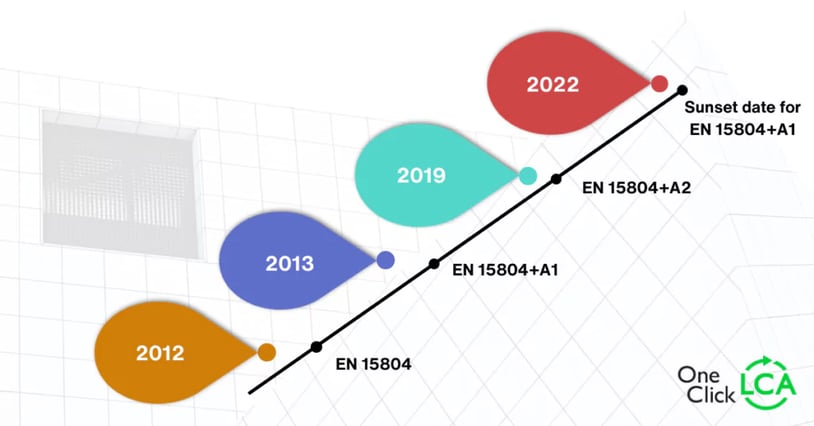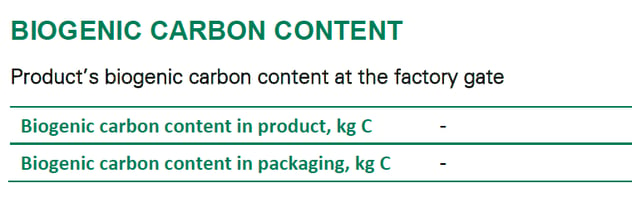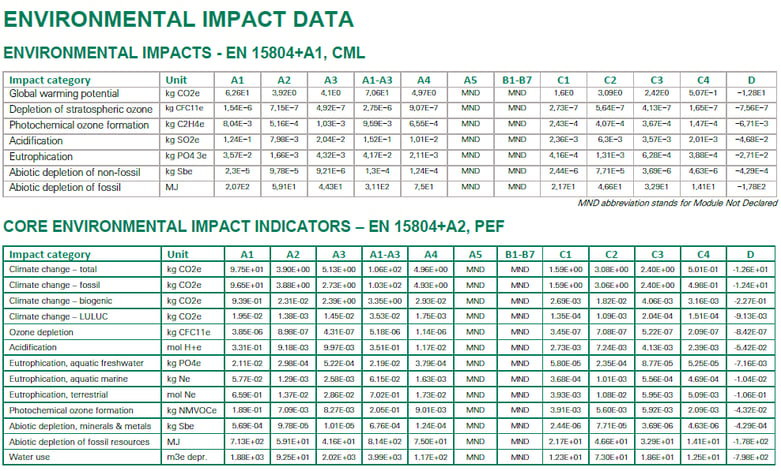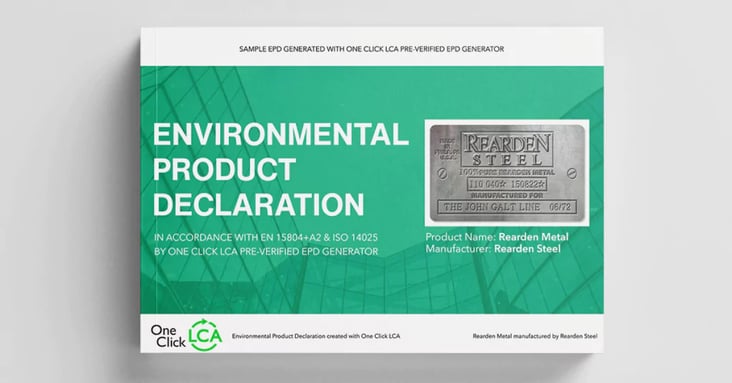The cornerstone EPD standard, EN 15804, has been widely adopted worldwide. The major amendment, EN 15804+A2, was approved in July 2019 and became mandatory in October 2022 for all new environmental product declarations (EPDs). In January 2025, the revised Construction Products Regulation (CPR) entered into force, introducing additional requirements for EPDs that align with the EN 15804 standard. In this article, we explain the impact of these changes, their regulatory implications, and how manufacturers can ensure compliance.
Listen to the article

Summary of changes coming with EN 15804+A2
- It is mandatory from July 2022, but not compliant with ISO 21930, a problem for exporters
- Biogenic carbon emissions and storage handling are fully revamped – for the better
- 19 environmental impact categories and 17 other reporting categories are now required
- All products must declare an end-of-life scenario and module D, with more complex rules
- In addition to the new standard, also a new EN 15804+A2 compliant PCR is required
- Data must also be available in ILCD format (but no requirement to share to third parties)
However, this is just a first step. By 2030 manufacturers will be expected to report the full range of environmental impact data contained within EN 15804-based Environmental Product Declarations (EPDs).
Pre-verified EPD Generator: It is a ready-made solution to comply with EN 15804+A2 and ensures compatibility with current requirements both in Europe as well as globally.
1. The EN 15804+A2 amendment and what it means for businesses

The European Standard EN 15804 Sustainability of construction works – Environmental product declarations – Core rules for the product category of construction products is globally the most used standard for creating Environmental Product Declarations (EPD) for construction products. The standard was originally developed on a mandate from the European Commission to harmonize declaration and calculation of the environmental performance of construction products on the European market. In the eight years since its inception, the standard has been amended twice.
The much-needed first amendment, or EN 15804+A1, made it mandatory to apply a common set of characterization factors, based on the so-called CML methodology developed by the University of Leiden. This ensured a reasonable level of comparability across environmental impacts in most impact categories for EPDs. Largely owing to the quality of the standards, ISO also decided to create a mirror standard of its own for EPDs. The International Standard ISO 21930 Sustainability in buildings and civil engineering works — Core rules for environmental product declarations of construction products and services is basically mirroring the most important provisions of EN 15804+A1. But EN 15804+A2 no longer complies with ISO 21930:2017 in terms of the impact categories it reports on. This creates a potential trade barrier, unless ISO 21930 is harmonized.
“EN 15804+A2 no longer complies with ISO 21930:2017 in terms of the impact categories it reports on. This creates a potential trade barrier, unless ISO 21930 is harmonized.”
The prevalence and quality of EPDs complying with EN 15804 has not gone unnoticed on the market. All public procurement bodies in the EU and EEA are bound to use EPDs complying with this standard, and they are also recognized by LEED and BREEAM, among other market-based systems. In the North American context, the standard is sometimes used with the TRACI 2.1 impact category reporting, a methodology developed by the US Environmental Protection Agency. However, since then, the European Commission has developed a new approach to quantifying the environmental performance of products called Product Environmental Footprint (PEF).
To align the environmental reporting approaches, the European Commission issued an amendment mandate to require the revision of EN 15804 to align with the PEF methodology. The irony in this is that, unlike EPDs, the PEF methodology has not taken off on the marketplace. However, the mandate was completed, and the result of the work is EN 15804:2012+A2:2019 Sustainability of construction works. Environmental product declarations. Core rules for the product category of construction products, or to be short, EN 15804+A2. Amendment 2 was approved by the European Committee for Standardization (CEN) on 21 July 2019. Every organisation issuing EPDs in compliance with EN 15804 needs to get their systems and processes aligned with the amendment within three years of its issuance. Unlike with standard revisions, the old version cannot be used after this date. But until July 2022 most people are expected to continue to use EN15804+A1 based data.
“Every organisation issuing EPDs in compliance with EN 15804 needs to get their systems and processes aligned with the amendment within three years of its issuance. Unlike with standard revisions, the unamended version cannot be used after this date.”
Solution:
2. Biogenic carbon emissions and storage handling are more transparent and fully revamped
One of the biggest changes in EN 15804+A2 concerns biogenic carbon in all forms. In EN 15804+A1, it was possible to deduce biogenic carbon stored in a product from cradle-to-gate impacts and add them back to represent their release in the end of life phase; but only if the product came from sustainably managed forestry. This created some contention within the industry, and EN 15804+A2 resolves these problems. In EN 15804+A2, the climate impact category is split into four different reported categories. The previous single Global Warming Potential category is no longer provided. The new categories are:
- Climate change – total (sum of subcategories)
- Climate change – fossil
- Climate change – biogenic
- Climate change – LULUC (land use and land use changes)


Solution:
3. Three times more impact categories, twice the fun
The EN 15804+A1 reports 7 impact categories, two of which represent resource depletion, as well as 17 reporting categories for resource use, waste generation and output flow data. The EN 15804+A2 does away with the former environmental impact categories, and requires no less than 13 core environmental impact indicators to be reported, and provides 6 additional environmental impact indicators (optional for the EPD, mandatory for the project report). The North American TRACI 2.1. itself reports yet another 6 impact indicators.

Illustration: difference in mandatory environmental impact categories in A1 and A2 standards
The division of climate change to subcategories is clearly beneficial. In addition, eutrophication has been divided into 3 subcategories, and the 6 additional environmental impact indicators provide data for human health impacts as well as land use related impacts. All environmental impact characterisation factors have also been replaced, bar abiotic resource depletion (these are still based on CML). All of which works out to 49 reporting categories. If that sounds like a lot, it is. The total number of reported categories is more than is needed, and all of it may not be useful, but considering the effort you put in to develop the EPDs in the first place, why take any chances of being caught short or having to redo it all in a year’s time?
Solution:
4. All products must declare end of life and a more complex recycling benefits calculation is required
The new standard makes the minimum scope for all products to cover modules A1-A3, C1-C4 and D. This means that products must declare both the cradle-to-gate as well as end-of-life phases, and the external impacts outside system boundary. Only a few products are exempt. At the same time, the rules for calculating the benefits for module D after end-of-life is now defined in a significantly more complex manner. The new calculation rules follow the PEF methodology. The calculation rules are provided in annex D of EN 15804+A2. The end-of-life scenarios can be a novelty and create a lot of work in documentation and declaration for manufacturers and consultants who did not have to work with them before.
Solution:
5. All Product Category Rules need to be revised
The standard amendment inevitably requires program operators to revise their Product Category Rules (PCR). To use the new standard version, a PCR based on the EN 15804+A2 is required. Not all program operators are yet ready for this, and some have part of their PCRs based on A1 and part of them based on A2. So, which PCR should you choose for your EPD? If you only have an A1-based PCR, you may risk having to redo your EPD sooner than you’d like. But not all product categories have an EN 15804+A2-compliant PCR available.
Solution:
6. Data must be available in International Reference Life Cycle Data System format
The EN 15804+A2 steps into the format of data as well, requiring that the data be available in the International Reference Life Cycle Data System (ILCD) format. The ILCD format is technically an XML file, and its purpose is to improve data exchange as well as nomenclature and data classification. This does not, however, constitute a requirement to share your business sensitive data with third parties. Availability is a technical requirement, not a requirement for additional disclosure.
Solution:
Is the EN15804+A2 a change for the better? How do I deal with it?
The change, overall, makes creating EPDs more complicated. This is clearly not compatible with our goal of making EPDs more accessible, so we created the One Click LCA Pre-Verified EPD Generator to allow manufacturers and consultants to create EPDs in line with the EN 15804+A2 while improving efficiency. To show what the outcome looks like in practise, we created a sample EPD for Rearden Steel, a fictive Pennsylvania-based manufacturer for their new product innovation, Rearden Metal

The EPD was generated with the One Click LCA Pre-Verified EPD Generator, which generates the EPD with all requisite data automatically. You can adjust your logo and product visualisation placement, and if you do not have business in North America, you can also remove the TRACI 2.1 impact categories for example. Come and create yours today.
Carbon Experts Newsletter
Industry news & insights — straight to your inbox
Want to learn more?
Panu Pasanen • Feb 12 2024
Panu Pasanen • Feb 13 2024
Melina Zacharia • Feb 14 2024
Melina Zacharia • Feb 09 2024
